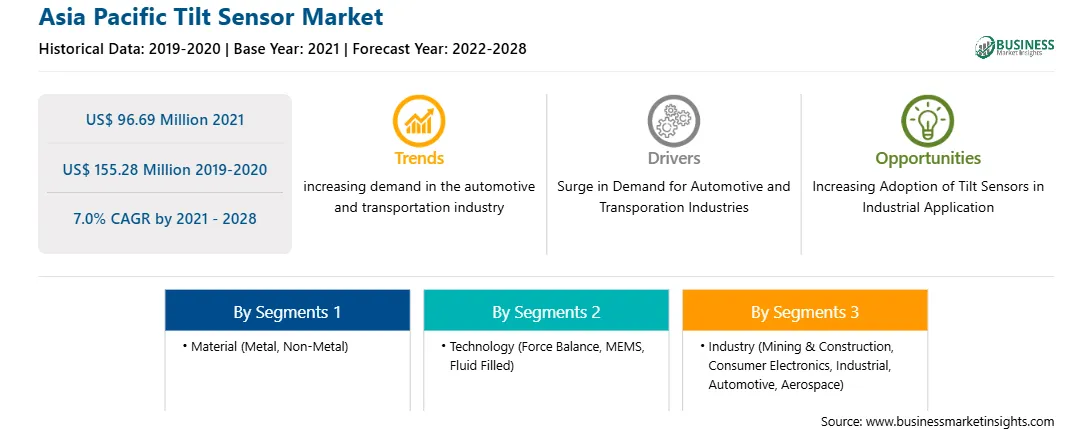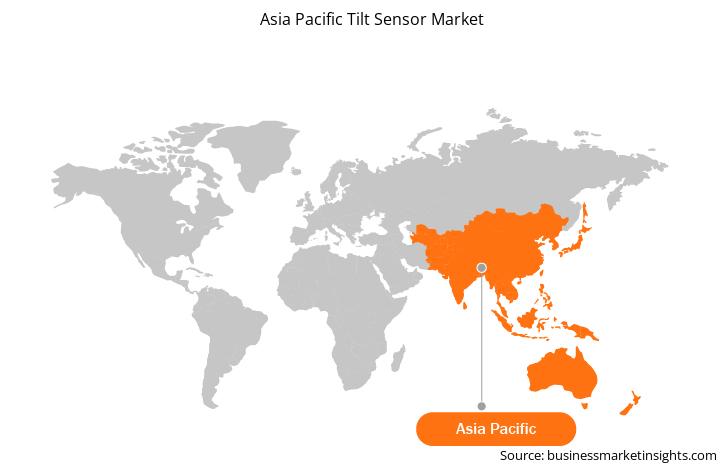Key factors contributing to the market growth are the growing uptake of tilt sensors in industrial application and a surge in demand for construction equipment. However, the high cost of tilt sensors based on force balance technology may hamper the market growth during the forecast period.
Industrial robots are used in various industries today, including semiconductors and autos, as well as plastics processing and metal forging. Almost any repetitive task, especially one that is risky or difficult for humans, is ideal for a robot. The use of robots in the manufacturing industry is particularly beneficial. They have traditionally been utilized in high-volume activities, but as technology progresses and the cost of industrial robots decreases, more options and opportunities for medium- and small-scale operations are becoming available.
When combined with other technologies, such as the industrial internet of things (IIoT) or 3D printing robots, industrial robots can deliver improved product quality and more precise and reliable procedures. Other added benefits are reduced cycle durations and real-time monitoring to better preventative maintenance procedures. An industrial robot accelerates the pace of manufacturing operations by running 24 hours a day, seven days a week. Breaks and shift changes are unnecessary for robots.
Robots' speed and dependability help cut cycle time and increase throughput. When robots perform repetitive jobs, workers are less likely to be injured, which is especially important when production occurs in harsh environments. Supervisors can also monitor the procedure from afar, either online or remotely. Having a person oversee many production tasks is frequently more expensive than using a robot. Workers' talents and knowledge can then be applied to other organization segments, such as engineering, programming, and maintenance. A tilt sensor is used to measure tilt angle with a ground plane reference in robotics. Sensors of this type are utilized in industries, service robots, and other domains, such as cellphones, gaming, and planes. Even if a robot moves on its legs or wheels, the inclination must be measured numerous times per second for the robot to retain its position. A tilt sensor measures tendency using one, two, or three axes, and the accuracy varies depending on the sensor. Temperature, gravity, vibration, shock, acceleration/deceleration, and a variety of other noise types all impact accuracy.
The COVID-19 outbreak has resulted in a massive financial loss in APAC. The governments in Asia Pacific countries have taken several crucial steps to contain the spread of the virus by imposing lockdown and physical distancing norms, which has negatively affected the manufacturing sector. China has a significantly large number of electronics and semiconductor manufacturing industries, with numerous manufacturers operating and supporting several industries worldwide.
The Chinese tilt sensor market players have observed a tremendous impact on respective business during Q1 of 2020, which have reflected a stiff decline in revenue generation, which resulted in a loss in China and the APAC tilt sensor market. In addition, China accounts for a significantly higher number of sensor system manufacturers. The lockdown measures and physical distancing norms imposed by the Chinese government during Q1 have reflected a massive fall in the supply of sensor systems, which ultimately resulted in decimated revenue generation in the tilt sensor market.
Construction is more important than ever in this challenging time. The sector has played a crucial role in responding to the crisis and in the recovery, from erecting hospitals in a matter of days to giving lifesaving equipment. The construction industry accounts for 13% of global GDP and increasing labor availability while addressing the most pressing construction-related requirements could assist drive recovery. However, the construction industry has suffered, and numerous countries' construction sites have closed. Most of the open locations have experienced supply chain disruptions and operating constraints. Financial indexes have reflected the disruption: Public engineering, construction, and building materials (ECB) businesses have plummeted much more than the average since 2021. Also, the social distancing norms due to the pandemic have increased the use of robots in various industries, tiling sensors as a significant component. These factors are expected to support the tilt sensors market in APAC.

Strategic insights for the Asia Pacific Tilt Sensor provides data-driven analysis of the industry landscape, including current trends, key players, and regional nuances. These insights offer actionable recommendations, enabling readers to differentiate themselves from competitors by identifying untapped segments or developing unique value propositions. Leveraging data analytics, these insights help industry players anticipate the market shifts, whether investors, manufacturers, or other stakeholders. A future-oriented perspective is essential, helping stakeholders anticipate market shifts and position themselves for long-term success in this dynamic region. Ultimately, effective strategic insights empower readers to make informed decisions that drive profitability and achieve their business objectives within the market.

| Report Attribute | Details |
|---|---|
| Market size in 2021 | US$ 96.69 Million |
| Market Size by 2028 | US$ 155.28 Million |
| CAGR (2021 - 2028) | 7.0% |
| Historical Data | 2019-2020 |
| Forecast period | 2022-2028 |
| Segments Covered |
By Material
|
| Regions and Countries Covered | Asia-Pacific
|
| Market leaders and key company profiles |
|
The geographic scope of the Asia Pacific Tilt Sensor refers to the specific areas in which a business operates and competes. Understanding local distinctions, such as diverse consumer preferences (e.g., demand for specific plug types or battery backup durations), varying economic conditions, and regulatory environments, is crucial for tailoring strategies to specific markets. Businesses can expand their reach by identifying underserved areas or adapting their offerings to meet local demands. A clear market focus allows for more effective resource allocation, targeted marketing campaigns, and better positioning against local competitors, ultimately driving growth in those targeted areas.


Strategic insights for the Asia Pacific Tilt Sensor provides data-driven analysis of the industry landscape, including current trends, key players, and regional nuances. These insights offer actionable recommendations, enabling readers to differentiate themselves from competitors by identifying untapped segments or developing unique value propositions. Leveraging data analytics, these insights help industry players anticipate the market shifts, whether investors, manufacturers, or other stakeholders. A future-oriented perspective is essential, helping stakeholders anticipate market shifts and position themselves for long-term success in this dynamic region. Ultimately, effective strategic insights empower readers to make informed decisions that drive profitability and achieve their business objectives within the market.

| Report Attribute | Details |
|---|---|
| Market size in 2021 | US$ 96.69 Million |
| Market Size by 2028 | US$ 155.28 Million |
| CAGR (2021 - 2028) | 7.0% |
| Historical Data | 2019-2020 |
| Forecast period | 2022-2028 |
| Segments Covered |
By Material
|
| Regions and Countries Covered | Asia-Pacific
|
| Market leaders and key company profiles |
|
The geographic scope of the Asia Pacific Tilt Sensor refers to the specific areas in which a business operates and competes. Understanding local distinctions, such as diverse consumer preferences (e.g., demand for specific plug types or battery backup durations), varying economic conditions, and regulatory environments, is crucial for tailoring strategies to specific markets. Businesses can expand their reach by identifying underserved areas or adapting their offerings to meet local demands. A clear market focus allows for more effective resource allocation, targeted marketing campaigns, and better positioning against local competitors, ultimately driving growth in those targeted areas.

The Asia Pacific Tilt Sensor Market is valued at US$ 96.69 Million in 2021, it is projected to reach US$ 155.28 Million by 2028.
As per our report Asia Pacific Tilt Sensor Market, the market size is valued at US$ 96.69 Million in 2021, projecting it to reach US$ 155.28 Million by 2028. This translates to a CAGR of approximately 7.0% during the forecast period.
The Asia Pacific Tilt Sensor Market report typically cover these key segments-
The historic period, base year, and forecast period can vary slightly depending on the specific market research report. However, for the Asia Pacific Tilt Sensor Market report:
The Asia Pacific Tilt Sensor Market is populated by several key players, each contributing to its growth and innovation. Some of the major players include:
The Asia Pacific Tilt Sensor Market report is valuable for diverse stakeholders, including:
Essentially, anyone involved in or considering involvement in the Asia Pacific Tilt Sensor Market value chain can benefit from the information contained in a comprehensive market report.